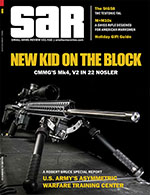Guns of the Silver Screen: V21N10
By Kyle Shea
Allied: Stens of Betrayal
It is 1940, and the British find themselves almost alone, fighting against the power of Nazi Germany. France, Belgium, Holland, Norway and Denmark have all fallen, and German troops are preparing for an invasion on the other side of the English Channel. The British army had been forced to abandon a large amount of its weapons and other equipment when it evacuated at Dunkirk, and the country now faces a possible invasion from occupied Europe. Before, the British had depended on Thompson submachine guns—but they were not enough, and they were expensive. To make matters worse, German U-boats had been sinking many supply ships carrying these guns from the U.S. Desperate, they sought to create a cheaper alternative that they could produce in their own country.
In 1940, the Sten was created by Major Reginald V. Shepherd and Harold J. Turpin. The name Sten actually comes from the first letters of their last names and the first two letters of “Enfield.” Stens were easy to make and cost far less than the American Thompson. The British made from 3 million to over 4 million depending on the information sources used, which sometimes include Canadian and other production in their numbers. There were a number of variants, each designated as a different Mark (MK), with the most common being the MK II. It served in the British Army well after the war, until it was slowly replaced by the Sterling submachine gun in the 1960s.
The Sten was one of the most used submachine guns in the world, seeing service in over twenty conflicts. Stens were even dropped behind enemy lines throughout the war to local resistance groups. They were light and easy to operate. The gun itself is an open bolt firearm, meaning that you pull the bolt back, and then the sear notch locks it in place. To fire it, you load the magazine and pull the trigger releasing the bolt, which strips a bullet and chambers then fires it on that forward stroke. This made it cheaper and easier to make and kept it from overheating.
Though it is a good gun, the Sten does have a number of problems. One is the magazine. A full one sometimes causes the weight of the gun to be unbalanced. Another problem is the gun’s relative inaccuracy; it is better at close quarters. The safety also had flaws, being nothing more than a slot in the receiver that the bolt handle latches into. It could dislodge from the notch easily and cause the weapon to accidently discharge. Another problem was that, with the gun having multiple manufacturers, its construction occasionally differed from the original design, leading to malfunctions in the field.
Despite these flaws, Sten submachine guns are popular with gun enthusiasts in the United States. The 32-round magazines are easy to find, but there are also 20-round magazines that were made by the Indian army. There is even a 50-round magazine, though it is more expensive and intended for the British Lanchester SMG. Other accessories include pouches, slings and magazine loaders. There are even bayonets, though they are very rare and hard to find.
In the movie “Allied,” Brad Pitt plays a secret agent who sneaks into Casablanca, Morocco, to assassinate a German ambassador during WW2. Joined by a French Resistance fighter played by Marion Cotillard, they use two Sten submachine guns they had hidden under a table. The guns themselves were smuggled into the country in a special suitcase (see the picture below).
“Allied” was an alright film. The story is about Brad Pitt’s character being told that his wife is a Nazi spy. He then spends most of the movie trying to discover the truth. The romance between the two leads is believable, and the few action scenes are good. Most of the acting is convincing, and the film does look historically accurate. However, it is a bit slow at times, with scenes that seem unnecessary. It is more a romance movie than a spy thriller. My favorite scenes were those set in Casablanca, and I wished that the rest of the movie had done them better justice. Still, the film is worth a watch.
Brad Pitt’s Stens from the bar scene had an extended barrel and handguard, an extra hole shown in comparison photos. This was so that his hand couldn’t slip forward in front of the barrel. Two were new in the box—the box in the pictures was the prototype box to hide them under the table in the assassination scene. Four guns were made from original WWII Sten SMGs. Two beaters were 77064 and R25623, and in the shooting scene at the club they had two that looked new—serial numbers FB7995 and 133856.
I’d like to thank Tony and Anne Watts and the wizards at Bapty & Co. in London, UK, for sharing this information with us.
This article first appeared in Small Arms Review V21N10 (December 2017) |
| SUBSCRIBER COMMENT AREA |
Rick.Notkin |
For shame. |
| Reply to this comment |
|






